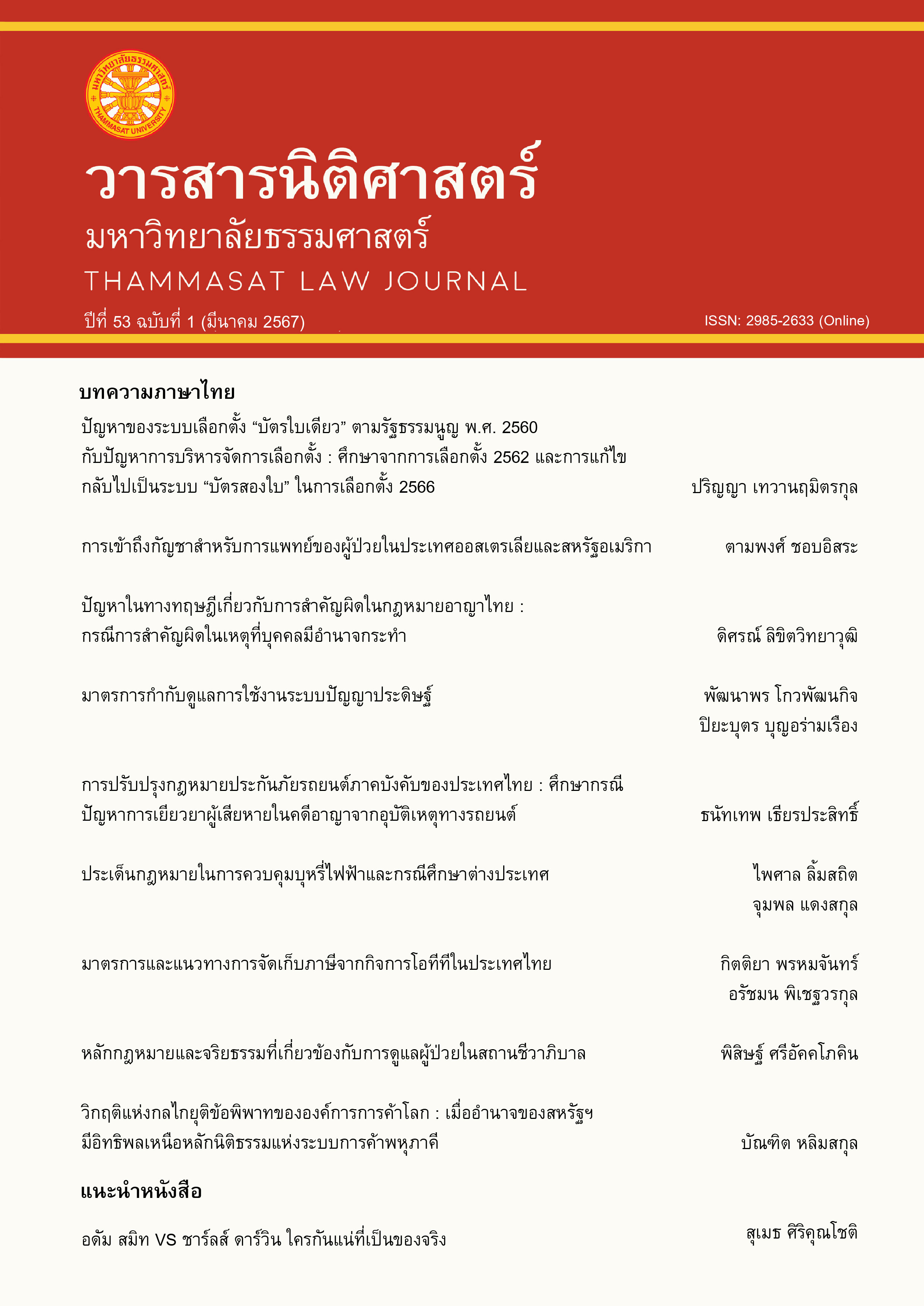มาตรการกำกับดูแลการใช้งานระบบปัญญาประดิษฐ์
คำสำคัญ:
ปัญญาประดิษฐ์, การประเมินความเสี่ยง, การกำกับดูแล, การประเมินเทคโนโลยีบทคัดย่อ
ประเด็นข้อกังวลการใช้งานระบบปัญญาประดิษฐ์นั้น ที่จริงแล้วไม่ใช่ประเด็นทางเทคนิคที่เข้าใจยากหรือเป็นประเด็นที่ขัดขวางการพัฒนา แต่เป็นเรื่องการประเมินและติดตามและผลกระทบเป็นสำคัญ กล่าวคือ มาตรการประเมินและติดตามอย่างไรที่เหมาะสม และเมื่อไหร่ที่ควรจะประเมินและติดตาม เพื่อให้เกิดผลสัมฤทธิ์ด้านการพัฒนาที่พึงปรารถนา โดยเฉพาะประเด็นอคตินั้นย่อมไม่มีใครต้องการให้เกิดขึ้น แต่หากไม่มีการบริหารจัดการความเสี่ยงที่ดีพอ ก็อาจจะกลายเป็นปัญหาใหญ่ได้ ดังนั้นจึงเป็นที่มาที่กล่าวได้ว่าทั่วโลกเริ่มให้ความสำคัญและเริ่มออกแนวทางการกำกับดูแลการใช้งานปัญญาประดิษฐ์ โดยจำแนกได้เป็น 2 ลักษณะ ได้แก่ การกำกับดูแลแบบทั่วไป (general regulation) และการกำกับดูแลเฉพาะเรื่อง (sector-specific regulation)
เอกสารอ้างอิง
‘AI Risk Management Framework’ (NIST 2023) NIST AI 100-1 <https://www.nist.gov/itl/ai-risk-management-framework> สืบค้นเมื่อ 9 กรกฎาคม 2566.
Anne De Piante Henriksen, ‘A Technology Assessment Primer for Management of Technology’ (1997) 13 International Journal of Technology Management 615.
Bradley Fidler, ‘Cybersecurity Governance: A Prehistory and Its Implications’ (2017) 19 Digital Policy, Regulation and Governance 449.
David Collingridge, The Social Control of Technology (St Martin’s Press 1980).
European Data Protection Board, ‘Guidelines 05/2022 on the Use of Facial Recognition Technology in the Area of Law Enforcement’<https://edpb.europa.eu/system/files/2022-05/edpb-guidelines_202205_frtlawenforcement _en_1.pdf> สืบค้นเมื่อ9กรกฎาคม 2566.
'New Vehicle General Safety Regulation’ (European Commission, 6 July 2022) <https://ec.europa.eu/commission/presscorner/detail/en/IP_22_4312> สืบค้นเมื่อ 9 กรกฎาคม 2566.
OECD, ‘OECD Framework for the Classification of AI Systems’ (OECD, 2022) <https://www.oecd-ilibrary.org/ science-and-technology/oecd-framework-for-the-classification-of-ai-systems_cb6d9eca-en> สืบค้นเมื่อ 8 กรกฎาคม 2566.
OECD, ‘Scoping the OECD AI Principles: Deliberations of the Expert Group on Artificial Intelligence at the OECD (AIGO)’ (OECD, 2019) <https://www.oecd-ilibrary.org/science-and-technology/scoping-the-oecd-ai-principles_d62f618a-en> สืบค้นเมื่อ 22 มิถุนายน2565.
Proposal for a Regulation of the European Parliament and of the Council Laying Down Harmonised Rules on ArtificialIntelligence (Artificial Intelligence Act) and Amending Certain Union Legislative Acts, COM/2021/206 final.
Rafael A Calvo, Dorian Peters and Stephen Cave, ‘Advancing Impact Assessment for Intelligent Systems’ (2020) 2 Nature Machine Intelligence 89.
Raija Koivisto and others, ‘Integrating Future-Oriented Technology Analysis and Risk Assessment Methodologies’ (2009) 76 Technological Forecasting and Social Change 1163.
Reva Schwartz and others, ‘Towards a Standard for Identifying and Managing Bias in Artificial Intelligence’ (2022) <https://www.nist.gov/publications/towards-standard-identifying-and-managing-bias-artificial-intelligence> สืบค้นเมื่อ 22 มิถุนายน 2565.
Rinie van Est, Bart Walhout and Frans Brom, ‘Risk and Technology Assessment’ in Sabine Roeser and others (eds), Handbook of Risk Theory: Epistemology, Decision Theory, Ethics, and Social Implications of Risk (Springer Netherlands 2012).
Roger Clarke, ‘Principles and Business Processes for ResponsibleAI’ (2019) 35 Computer Law & Security Review 410.
Stuart Russell and Peter Norvig, Artificial Intelligence: A Modern Approach (4th edn, Pearson 2020).
ดาวน์โหลด
เผยแพร่แล้ว
ฉบับ
ประเภทบทความ
สัญญาอนุญาต
ลิขสิทธิ์ (c) 2024 วารสารนิติศาสตร์ มหาวิทยาลัยธรรมศาสตร์

อนุญาตภายใต้เงื่อนไข Creative Commons Attribution-NonCommercial-NoDerivatives 4.0 International License.
ผลงานที่ตีพิมพ์ในวารสารนิติศาสตร์เป็นลิขสิทธิ์ของวารสารนิติศาสตร์ มหาวิทยาลัยธรรมศาสตร์ และวารสารนิติศาสตร์ มหาวิทยาลัยธรรมศาสตร์ สงวนสิทธิในการเผยแพร่ผลงานที่ตีพิมพ์ในแบบรูปเล่มและทางสื่ออิเล็กทรอนิกส์อื่นใด
บทความหรือข้อความคิดเห็นใด ๆ ที่ปรากฏในวารสารนิติศาสตร์เป็นความรับผิดชอบของผู้เขียนโดยเฉพาะ คณะนิติศาสตร์ มหาวิทยาลัยธรรมศาสตร์ และบรรณาธิการไม่จําเป็นต้องเห็นด้วยหรือร่วมรับผิดชอบใด ๆ



